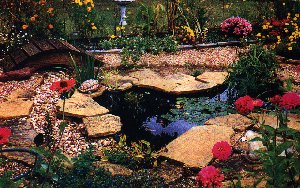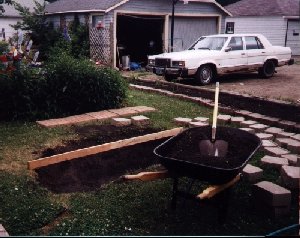| LinkExchange Member | Free Home Pages at GeoCities |
Pond A, B, C's
Ah, imagine closing your eyes....
and being transported, by sounds of a gently laughing brook. Or relaxing with friends on a blamy summer evening next to your own pond, moon - or torchlight shimmering on the surface of the water. The fragrance of waterlilies lingers in the air, a frog calls from the reeds on the far bank, now and again a fish breaks the surface. Sigh....life doesn't get much better!Ponds are surprisingly easy to build, and give a new dimension to your garden. Ours was a pipe dream for three years before we actually picked up the shovel and got down to business. We'd sit around and talk about it; drag out the pond books time and time again; scrutinize our plan right and left, but mostly, sketch....resketch....
So, Where Do I Start Digging?
The style of pond you choose to build will influence the site you select. A formal pond, usually rectangular and often with a fountain, looks fine placed in the center of an expanse of level lawn. A naturalistic pond, however, looks better in a protected nook of your garden, where its irregular shape might blend with existing landscape features to make it appear as if it has always been there. Or, you might want to consider placing the pond near your patio, so that you can enjoy it more fully.A location in full sun is best if you plan to stock you pond with flowering aquatic plants. Some pond plants, however, can tolerate shade for a few housrs a day. Leeward or open sites reduce the bother of removing debris which might fall or be wind-blown onto the pond surface.
It is unwise to place a pond beneath a tree, since you will be constantly cleaning leaves and needles from it, and the roots of the tree will force their way through the pond. Nor is the base of a slope a suitable location, unless a berm is constructed to prevent rains from washing material into the pond.
Mark the perimeter in your selected site with a piece of garden hose to lee how the pond will fit its setting. If you want the enduring pleasure of watching a background, the sky, or the horizon reflected on the surface of the water, temporarily place a goodsized mirror where the pond will lie (taking care that the mirror is level) and observe the reflections from the normal viewing area.
What's That Design...

There are many designs and plans. We used the garden hose to outline a crescent shape about 8 feet by 5 feet. Since it was a spur of the moment decision to actually get the shovels out, the only color spray paint we could find was hot pink (naturally). We then sprayed a line on the grass, using the hose as a guide...made the grass look rather festive for an hour or two. Here's a picture which shows the open hole. We used a 2x4, laid across the hole, to keep us level.

Pond created with a preformed mold: make a hole several inches larger than the preformed pool. Save the soil to cover the edges later. Put a bed of sand in the hole before putting the mold in place. Once your pond is in place, put a spirit level on top of a 2x4 straddling the pond to make sure that it is sitting level in the ground. Pour sand mixed with water along the space between the mold and the wall of the hole at the same time as you fill the pond with water. This will help seat the pond snugly in its hole.
Pond created with flexible liner: fill the pond cavity with at least 2 inches of sandy soil before laying the liner. For each foot of depth, add 2 feet to the length and width dimensions. Turn edges under instead of trimming. Once liner is laid in, secure edges with rocks and dirt.
The depth of your pond is an important factor if you plan to have aquatic plants which root under the water's surface. Eighteen to thirty inches is the range of depth for optimum growth and flowering of most varieties of water lilies. Alternatively, there are many attractive bog plants which will prosper in 6 inches or less of water. A well-designed pond for aquatic plants will have at least one section deep enough for water lilies as well as some shallow planting pockets built into the edge of the pond. Remember that one water lily can have a spread of 3 to 5 feet on the water's surface.
A shallow pool can be made to appear deeper by painting its bottom a dark color. Shallow pools are easier to illuminate internally at night but less effective as reflecting pools. If children have access to a deep pool, affix a steel grating beneath the surface through which fish and plants can move, but children cannot step.
With a naturalistic pond, perhaps you will want to add a small waterfall trickling over some starategically placed boulders into your pond. On a sloping site, it is even possible to link a series of small pools which cascade down into each other. I'm not going to talk much, here, about pond scum....just know that about a week or two after you fill your pond, you'll be blest with it. The best advise I can give you is to skim the surface each day with a net or cloth. Some folks control a severe explosion by running cool water into the pond and shading it during the day with a patio umbrella.
....more on design....
In many metro areas, smaller preformed ponds are available commercially in a variety of sizes, colors, and shapes. These ready-to-use pools are relatively easy to install, and their durability depends upon the kind of treatment they receive.
heavy-gauge flexible liners (made of PVC, EPDM, or butyl rubber sheeting) make inexpensive and surprisingly durable ponds if sharp stones are kept from coming into contact with them. The liner we used came in a kit from Menards. The PVC liner was about 20 gauge.
The minimum gauge width of the liner should be .03 millimeters. Installation is quick and simple, since any irregular hole may be used for the pond. Many types of aquatic plants can grow in a 6-inch layer of soil added to the bottom of the pond, on top of the liner. But more on plants later.
Concrete makes by far the most versatile and durable type of pond, although it entails the most work. Concrete can be shaped and sculpted, textured, inlaid, or colored to accommodate any plan.
Be sure to prepare the site with rebar and reinforcing mesh, and not to pour wet concrete onto dry. The two will not stick, and the second layer will seel badly. A minimum thickness of 4 inches of concrete will hold up well. To increase its strength, concrete should be covered while drying with wet burlap and kept wet for several days. Once the pond is complete, fill it with water and let it sit for a few days to allow the lime in the concrete to leach out, then flush and refill once or twice more before trusting the pond to fish or aquatic plants.
So Now What?
Plantings near your pond should complement and blend with your existing landscape. Reeds or other shallow-water plants can go along the banks. Brightly-colored flowers are especially appealing across water. Fountains, waterfalls, and large rocks make splendid additions, benefiting fish by providing protective cover and aeration of the water. A shallow area will attract birds, but surround such areas with deeper water, or keep adjacent ground cover sparse to prevent cats from making this a hunting ground. If you install a fountain or waterfall, you may wish to contain the resulting surface disturbance by sculpting a catch basin and containing berm that comes within an inch or so of the surface. Some aquatic plants, such as waterlilies, need calm water to thrive.
Many types of fish do well in still ponds and eliminate the need to spray for mosquitoes. A spuare foot of surface area will support twenty inches of length (minus tail) of fish. Also, frogs will be naturally attracted to your pond, and will bring the soothing sounds of summer to the area. Fish or water turtles can remain in the pond year round, even in harsh winters, if a depth of at least 40 inches and sufficient warmth are provided to prevent freezing over of the pond's center. In cold climates, a floating heater will prevent freezeover, but will require the addition of a nearby outlet with ground-fault protection (also handy for lighting). A temperature setting around 40 degrees will not disturb dormant fish, but will keep a sizable hole open. never chop the ice to open a hole as the impact can injure or kill pond inhabitants.
Below, you will find a site index along with other homesteading links
| View Guestbook | |||
Last Updated July 10, 1998


